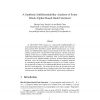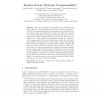51 search results - page 4 / 11 » The Random Oracle Model and the Ideal Cipher Model Are Equiv... |
PKC
2007
Springer
14 years 2 months ago
2007
Springer
Abstract. Key-insulated cryptography is a crucial technique for protecting private keys. To strengthen the security of key-insulated protocols, Hanaoka, Hanaoka and Imai recently i...
DCC
2008
IEEE
14 years 8 months ago
2008
IEEE
At ASIACRYPT 2006, Chang et al. analyzed the indifferentiability of some popular hash functions based on block ciphers, namely, the twenty collision resistant PGV, the MDC2 and th...
SACRYPT
2004
Springer
14 years 1 months ago
2004
Springer
Abstract. This paper formalizes the security adversarial games for online symmetric cryptosystems in a unified framework for deterministic and probabilistic encryption schemes. On...
ASIACRYPT
2010
Springer
13 years 6 months ago
2010
Springer
This paper investigates the Random Oracle Model (ROM) feature known as programmability, which allows security reductions in the ROM to dynamically choose the range points of an ide...
ASIACRYPT
2009
Springer
14 years 3 months ago
2009
Springer
Adaptive oblivious transfer (adaptive OT) schemes have wide applications such as oblivious database searches, secure multiparty computation and etc. It is a two-party protocol whic...


